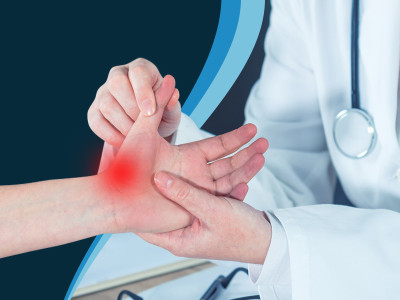Posted by Joe O'Mahony on 3rd Sep 2021
Carpal tunnel syndrome is a painful wrist based condition, caused by pressure put on surrounding nerves and tendons.
In this blog, we go into detail about what carpal tunnel syndrome is, who it affects and the most effective way to relieve symptoms caused by CTS.
- What is Carpal Tunnel Syndrome?
- Who can Carpal Tunnel Syndrome Affect?
- Relieving Carpal Tunnel Syndrome
- Recommended Products
What is Carpal Tunnel Syndrome?
Carpal tunnel syndrome (also known as CTS) is a painful injury that results from pressure being placed on the median nerve, which travels through an opening called the carpal tunnel to your hand. The carpal tunnel, located in the wrist area of the body, contains tendons and ligaments as well as bones (including eight small "carpal bones"). The nine-inch tunnel is surrounded by a ligament that helps hold the bones and everything in place, but it also restricts the amount of space available for passing through.
Carpal tunnel syndrome results when swelling or inflammation causes the carpal ligament to become tight, thus restricting passage. This can result in pain and numbness in one or more of your fingers. In extreme cases, carpal tunnel syndrome may lead to the need for surgery, but there are many non-surgical steps that can be taken before resorting to removing a bone or two.
Who can Carpal Tunnel Syndrome Affect?
People who use a computer keyboard or other equipment that requires extensive typing are susceptible to carpal tunnel syndrome and it is the most common cause of hand numbness, pain, tingling and stiffness in sufferers. The median nerve controls sensation and movement in your thumb, index finger, long finger, palm, and half of your ring finger. Damaging this nerve is a common cause for carpal tunnel symptoms.
Chronic diseases, such as diabetes, rheumatoid arthritis, and hypothyroidism, may be the result of carpal tunnel syndrome. However, researchers believe that genetics also play a role in those with family histories or premature-age patients who develop the symptoms. There are other factors that can contribute to carpal tunnel syndrome, such as wrist trauma, wrist fractures, thumb injuries, pregnancy or athletic activities.
Relieving Carpal Tunnel Syndrome
In extreme cases, carpal tunnel syndrome may lead to the need for surgery, but there are many non-surgical steps that can be taken to reduces symptoms caused by CTS:
- If you sit at a computer for long hours every day, you should take breaks from repetitive tasks to reduce carpal tunnel syndrome symptoms. During the breaks, stretch out your hands and fingers, move around in circles with your wrist flexed or extended, flex your joints to increase circulation and improve muscle flexibility.
- Holding your wrist in a neutral position relieves the pressure applied on the median nerve, therefore reducing pain and inflammation. Wrist splints such as the Actesso Advanced Wrist Support contain a metal palmar bar which rests comfortably on top of the wrist. This holds your wrist in the neutral position whilst still allowing for mobility to complete your daily tasks.
- Keeping your hands warm. The heat-retaining qualities of the Advanced Wrist Support encourage circulation around the affected area, reducing inflammation of tendons and ligaments around the carpal tunnel. Wearing gloves and using hand warmers on colder days will also reduce pain caused by CTS significantly.
For relieving symptoms of Carpal Tunnel Syndrome, we recommend:

The Breathable Wrist Support
The smart, ventilated design of the Breathable wrist support
helps to keep the wrist cool throughout the day and overnight.



